Magnetism and Electricity Questions and Answers Grade 10
Share via Whatsapp Join our WhatsApp Group Join our Telegram GroupQuestions
Question 1: Multiple choice
Choose the correct answer. Write only the letter of the answer you select.
1.1 Which of the following statements about magnetic field lines is/are true?
- They surround a magnet in two dimensions.
- They cannot cross.
- They represent the direction in which the south pole of a compass will point.
- 1 and 2 only
- 2 and 3 only
- 2 only
- 1, 2 and 3 (3)
1.2 Which one of the substances below will be attracted by a magnet?
- copper
- water
- lead
- cobalt (3)
1.3 A small, neutral, metal sphere becomes charged when it is brought into contact with a positively charged rod. In the process the sphere …
- loses electrons.
- loses protons.
- gains protons.
- gains electrons. (3)
1.4 An insulated metal sphere carries a charge of –7 μC. An identical sphere carries a charge of –9 μC. The spheres are brought together to touch and are then sepa- rated. What is the charge on each sphere now?
- –16 μC
- –8 μC
- –1 μC
- +8 μC (3)
1.5 Two identical metal spheres, X and Y, are mounted on insulating stands. Sphere X has a charge of +8 μC and sphere Y is neutral. The spheres are allowed to touch and are then separated. What is the charge on X?
- 0
- –8 μC
- +4 μC
- +8 μC (3)
1.6 An insulator can be attracted by a charged plastic ruler because …
- the insulator atoms are always polarised.
- the insulator atoms become polarised when close to the charged ruler.
- an insulator contains free electrons.
- electrons in the insulator move to one side of the insulator, thereby polarising the whole insulator. (3)
1.7 The SI unit for current is …
- ampere.
- coulomb.
- ohm.
- volt. (3)
1.8 You wish to connect a circuit to measure the current in a resistor and the potential difference across it. Which circuit below is connected correctly?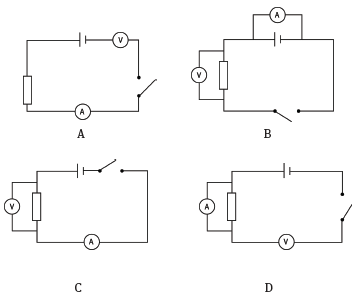 (3)
(3)
1.9 A volt can be described as a …
- coulomb per second.
- joule per ampere.
- ampere per second.
- joule per coulomb. (3)
1.10 A conductor carries a current of 2 A. What is the total charge that passes through the conductor in 4 minutes?
- 480 C
- 8 C
- 2 C
- 0,5 C (3)
1.11 Three resistors each have a resistance of 6 Ω. Which of the following correctly gives their equivalent resistance when first connected in series, then in parallel?
- 18 Ω and 3 Ω
- 18 Ω and 2 Ω
- 2 Ω and 18 Ω
- 18 Ω and 0,5 Ω (3)
1.12 Which pair of words, in order, correctly completes the following statements?
When the length of a resistor is increased, its resistance … When the thickness of a resistor is decreased, its resistance …
- increases, increases
- increases, decreases
- decreases, decreases
- decreases, increases (3)
1.13 Three resistors, each of resistance 4 Ω, are to be used to make a 6 Ω combination. Which arrangement will achieve this?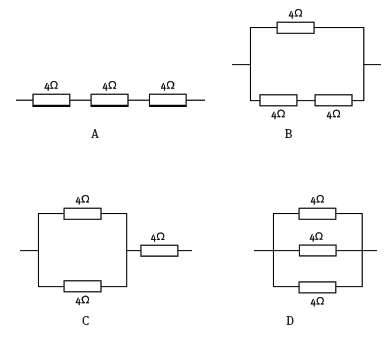 (3)
(3)
1.14 You are given this section of an electric circuit Which of the following statements is/are correct?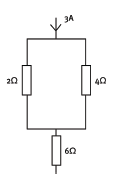
- The current in the 2 Ω resistor is 2 A.
- The current in the 4 Ω resistor is 1 A.
- The current in the 6 Ω resistor is 3 A.
- 3 only
- 2 and 3 only
- 1 and 2 only
- 1, 2 and 3 (3)
1.15 In the given circuit, the equivalent resistance between X and Y is …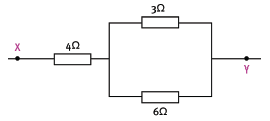
- 4,5 Ω
- 5 Ω
- 13 Ω
- 6 Ω (3)
1.16 The bulbs in this circuit are all identical. If the reading on ammeter A1 is 6 A, what is the reading on ammeter A2?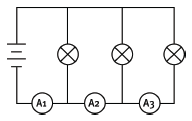
- 2 A
- 3 A
- 4 A
- 6 A (3)
1.17 The resistance of a conductor does not depend on …
- length.
- potential difference.
- temperature.
- type of material. (3)
1.18 One of the bulbs in this circuit breaks and that causes all the other bulbs to go out as well. Which bulb broke?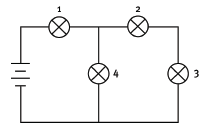
- 1
- 2
- 3
- 4 (3) 18 × 3 = [54]
Question 2: True/false
Indicate whether the following statements are true or false. If the statement is false, write down the correct statement.
2.1 When a bar magnet is broken in half, one half is a north pole only and the other half is a south pole. (2)
2.2 The SI unit for resistance is the volt per coulomb, given the name ohm. (2)
2.3 In any series electrical circuit we will find the biggest potential difference across the resistor with the biggest resistance. (2)
2.4 The voltage across the terminals of a battery always decreases when the battery starts to deliver current to the circuit, due to the resistance of the battery. (2)
2.5 The total potential difference across three resistors connected in parallel is equal to the sum of the potential differences across each resistor. (2) 5 × 2 = [10]
Question 3: One-word answers
Provide one word or term for each of the following descriptions. Write only the word or term next to the question number.
3.1 A region where a magnetic substance will experience a force.
3.2 A substance that will not allow a flow of charge through it.
3.3 The voltage measured across the terminals of a battery when it is not providing current to a circuit.
3.4 The SI unit for charge.
3.5 The rate of flow of charge. 5 × 1 = [5]
Question 4: Matching pairs
Choose an item from column B that matches the description in column A. Write only the letter of your choice (A–J) next to the question number.
Column A | Column B |
4.1 axis on which Earth spins | A plastic |
4.2 charging by rubbing | B voltage dividers |
4.3 polarised molecules | C geographic N and S poles |
4.4 resistors in parallel | D ammeter |
4.5 measuring instrument that is con- nected in series | E induction |
F water | |
G current dividers | |
H magnetic N and S poles | |
I voltmeter | |
J tribo-electric |
5 × 2 = [10]
Question 5: Long questions
You are given a painted metal rod and a magnet. Explain how you could show whether the painted metal rod is …
5.1 non-magnetic (for instance, copper). (2)
5.2 magnetic, but not a magnet. (2)
5.3 a magnet. (2) 3 × 2 = [6]
Question 6: Long questions
6.1 Explain the difference between a magnetic field and a magnetic field line. (4)
6.2 What is meant by the ‘north pole’ of a magnet? (2)
6.3 You are given two identical magnets of equal strength. You place them with the north pole of one facing the south pole of the other, as shown.
6.3.1 Draw the magnets in the area of the dotted line box, then sketch the mag- netic field pattern in the area of the box. (4)
6.3.2 How would the pattern change if both magnets were much weaker? (2) [12]
Question 7: Long questions
7.1 Explain the difference between the geographic north pole and the magnetic north pole of the Earth. (4)
7.2 What is the angle between the lines drawn between the geographic N and S, and the magnetic N and S? (1) [5]
Question 8: Long questions
8.1 Name the three particles that make up an atom, and state the charge on each. (3)
8.2 Why are the names ‘positive’ and ‘negative’ used for the two types of charge? (3) [6]
Question 9: Long questions
Plastic carrier bags are made of polythene. A strip is cut from a carrier bag and rubbed with a cloth or by pulling it through your fingers. When it is then hung from a string as shown, the ends push apart. Explain why this happens. (4)
[4]
Question 10: Long questions
10.1 Explain why a water molecule is said to be ‘polarised’. Draw a labelled sketch of a water molecule to illustrate your answer. (4)
10.2 A plastic rod is charged positively by rubbing it with cloth. When it is brought near to a thin stream of water from a tap, the water is attracted to the rod.
10.2.1 Explain in terms of transfer of charge how the rod became positively charged. (2)
10.2.2 What name if given to the process of charging an object by rubbing? (1)
10.2.3 The charge on one electron is 1,6 × 10–19 C. If 3,6 × 106 electrons were trans- ferred in the rubbing process, calculate the charge on the rod. (4)
10.2.4 Explain why the water is attracted. (4) [15]
Question 11: Long questions
11.1 How would you measure the emf of a battery? Explain why this works. (2)
11.2 Why is the emf of a battery always slightly higher than the potential difference that it can provide to an electric circuit? (4) [6]
Question 12: Long questions
Study the circuit diagram and answer the questions below.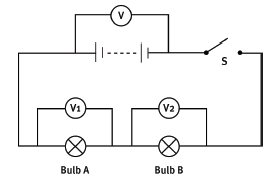
12.1 Is the resistance of a voltmeter very high or very low? Explain how this affects the measurement of voltage. (4)
12.2 When switch S is open, as shown, the reading on voltmeter V is 10 V. Switch S is then closed and the voltmeter reading drops to 9 V. Explain why. (5)
12.3 How much energy does the battery give to each coulomb of charge that it pushes out into the circuit? (1)
12.4 If the reading on voltmeter V1 is 4 volts, what is the reading on V2? (2)
12.5 How much energy is lost by each coulomb of charge as it passes through bulb A? (2)
12.6 Into what two forms of energy is it transformed in bulb A? (2) [16]
Question 13: Long questions
In the above circuits, the bulbs and cells are not all identical. The readings on some of the voltmeters are given. What are the readings on the other voltmeters V1 to V4? [8]
Question 14: Long questions
In the above circuits, the light bulbs are not all identical. The readings on some of the ammeters are given. What are the readings on the other ammeters A1 to A5? [10]
Question 15: Long questions
15.1 Define current. (2)
15.2 Name the instrument used to measure current. (1)
15.3 Does this instrument have a very high or a very low resistance? Give the reason for your answer. (3)
15.4 An electric light bulb carries a current of 0,25 A. Calculate the time taken for 30 C of charge to pass through the bulb. (4) [10]
Question 16: Long questions
16.1 State the four factors that determine the resistance of a resistor. (4)
16.2 Why are metals good conductors of electricity? (2)
16.3 Explain why a metal can get hot when carrying an electric current. (4) [10]
Question 17: Long questions
17.1 What name is given to a ‘volt per ampere’? (1)
17.2 When an electric heater is connected to the electricity mains of 240 volts, the cur- rent is 5 amperes.
17.2.1 How many volts are required to produce a current of one ampere in the bulb? (3)
17.2.2 What is the resistance of the bulb? (1) [5]
Question 18: Long questions
An electric circuit consists of a battery of four cells connected to two resistors and an ammeter all connected in series. The resistances are 6 Ω and R (representing an unknown resistance). The ammeter reads 1 A. The potential difference across the 6 Ω resistor is 6 V. A voltmeter connected across the battery reads 8 V.
18.1 Draw the circuit diagram, entering all the given information. (4)
18.2 What is the potential difference across R? Explain your answer. (3)
18.3 Is the resistance of R greater than or less than 4 Ω ? Explain your answer. (3)
18.4 What is the current in R? Give a reason for your answer. (2)
18.5 How much charge passes through the 6 Ω resistor in 1½ minutes? (4) [16]
Question 19: Long questions
Consider the circuit given in the diagram below.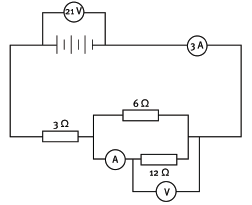
19.1 Calculate the equivalent resistance of the parallel combination. (4)
19.2 What is the total resistance of the whole circuit? (2)
19.3 If the potential difference across the 3 Ω resistor is 9 V, what is the reading on voltmeter V? (2)
19.4 If the current in the 6 Ω resistor is 2 A, what is the reading on ammeter A? (2)
19.5 How much charge passes through the 3 Ω resistor in 20 s? (4) [14]
Answers
1.1 C
1.2 D
1.3 A
1.4 B
1.5 C
1.6 B
1.7 A
1.8 C
1.9 D
1.10 A
1.11 B
1.12 A
1.13 C
1.14 D
1.15 D
1.16 C
1.17 B
1.18 A 18 × 3 = [54]
2.1 False. When a bar magnet is broken in half, each half remains being a magnet, each with a north pole and a south pole.
2.2 False. The SI unit for resistance is the volt per ampere, given the name ohm.
2.3 True.
2.4 True.
2.5 False. The total potential difference across three resistors connected in series is equal to the sum of the potential differences across each resistor. 5 × 2 = [10]
3.1 magnetic field
3.2 insulator
3.3 emf
3.4 coulomb
3.5 current 5 × 1 = [5]
Question 4: Matching pairs
4.1 C
4.2 J
4.3 F
4.4 G
4.5 D 5 × 2 = [10]
Question 5: Long questions
5.1 Hold the magnet close to the painted metal rod. If there is no attraction, the painted rod is not magnetic.
5.2 If the painted rod is attracted by both poles of the magnet, the painted rod is magnetic, but not a magnet.
5.3 If the one end of the painted rod is attracted by the north pole of the magnet, while the other end of the rod is repelled by the north pole, then the painted rod is a magnet. 3 × 2 = [6]
Question 6: Long questions
6.1 A magnetic field is simply a region where a magnet or magnetic material will experience a force. Magnetic field lines are imaginary lines that are drawn to show the direction in which the north pole of a compass would point if placed at any point on the lines.
6.2 If the magnet is suspended so it can swing freely, the north pole of the magnet is the end that will point towards to north pole of the Earth under the action of the magnetic field of the Earth.
6.3.1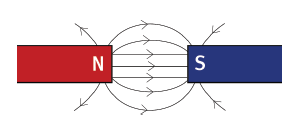
Shape of field
Direction of arrows
6.3.2 All field lines would be further apart. [12]
Question 7: Long questions
7.1 The geographic north pole is the northern point of the axis around which the Earth spins.
The magnetic north pole is the point towards which the north pole of a compass will point.
7.2 11,5° [5]
Question 8: Long questions
8.1
- proton – positive
- electron – negative
- neutron – neutral
8.2 The charge on a proton equals that on an electron, but when a proton and an electron are brought together, the charge cancels to give a total charge of zero. This is the same as considering a proton to have a charge of +1 and an electron –1, so if added together equals zero. [6]
Question 9: Long questions
When the polythene strip is rubbed, electrons are transferred onto the strip making the whole strip negatively charged. When hung over the string, the two ends of the strip repel each other, as negative repels negative. [4]
Question 10: Long questions
10.1 The oxygen atom attracts electrons in the molecule more strongly than the hydrogen atoms. This makes the oxygen end of the molecule slightly negatively charged and the hydrogen end slightly positively charged. 
10.2.1 Negatively charged electrons were rubbed of the rod onto the cloth. This left more protons than electrons on the rod, making the whole rod positively charged.
10.2.2 tribo-electric charging
10.2.3
- Q = nqe
= (3,6 × 106) × (1,6 × 10–19)
= 5,76 × 10–13 C
10.2.4
- The positive rod attracts oxygen atoms in the water molecules and repels the hydrogen atoms. This causes the molecules to rotate, so that the whole stream is polarised with the side of the stream closest to the rod being negative and the side furthest from the rod positive. Because all oxygen atoms are now closer to the rod than hydrogen atoms, the force of attraction is stronger than the force of repulsion, so the whole stream is attracted. [15]
Question 11: Long questions
11.1 Connect a voltmeter directly to the battery. Because the voltmeter has very high resistance, the current is effectively zero. The reading on the voltmeter is the emf.
11.2 The resistance of the circuit is much lower than that of the voltmeter, so the cur- rent in the battery is now large. The battery has resistance, so some of the energy provided to the charge by the battery is used up in the battery itself, leaving less available for the circuit. [6]
Question 12: Long questions
12.1 Very high. A voltmeter is connected in parallel across the resistor(s) where it measures potential difference. By having a very high resistance, very little cur- rent passes through the voltmeter.So the voltmeter does not affect the current in the circuit.
12.2 When the switch is open, current from the battery passes only through the voltmeter of very high resistance. This current is so small that it is effectively zero. So the emf is 10 V. When the switch is closed, the current through the battery is now the same as the current in the circuit and is much larger. Be- cause the battery has resistance, some of the energy supplied by the battery is transformed into heat inside the battery, so only 9 V is available for the external circuit.
12.3 9 J
12.4 5 V
12.5 4 J
12.6 heat and light [16]
Question 13: Long questions
V1 = 1 V
V2 = 6 V
V3 = 12 V
V4 = 12 V [8]
Question 14: Long questions
A1 = 2 A
A2 = 3 A
A3 = 5 A
A4 = 2 A
A4 = 1,5 A [10]
Question 15: Long questions
15.1 Current is the rate of flow of charge.
15.2 Ammeter
15.3 Very low resistance. An ammeter is connected in series in a circuit. It must have a very low resistance so that it does not affect the current in the circuit.
15.4 I = Q / Δt Δt = Q / I = 30 / 0,25 = 120 s [10]
Question 16: Long questions
16.1 type of material; length; thickness; temperature
16.2 Some of the electrons in a metal are held loosely by the nucleus, so they are free to move.
16.3 The battery sets up an electric field in the circuit. This forces all loose electrons in the circuit to move from the negative towards the positive terminal. The electrons collide with the atoms of the metal, causing them to vibrate faster and heat up. [10]
Question 17: Long questions
17.1 ohm
17.2.1 If a voltage of 240 volts produces a current of 5 amperes, 1 ampere will be produced by (240 ÷ 5) = 48 volts
17.2.2 48 Ω [5]
Question 18: Long questions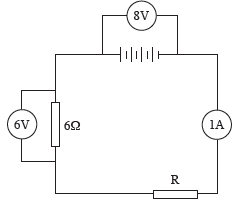
18.1 The 6 Ω resistor, resistor R and the ammeter can be connected in any order.
18.2 2 V The resistors in series are voltage dividers – they divide the voltage of the battery in proportion to the resistances of the resistors. The voltages across the two resistors together must add up to 8 V.
18.3 Less than 4 Ω. Voltage is divided in proportion to the resistance. R has the smaller proportion of the voltage, so must have the smaller resistance.
We can actually predict that the resistance of R is 2 Ω, because the ohm is defined as a volt per ampere. The current in R is 1 ampere and the potential difference across it is 2 volts, therefore 2 V A–1 = 2 Ω. We can calculate the resistance another way. The voltage of the battery is divided in proportion to the resistance. R takes ¼ of the voltage of the battery, so must have ¼ of the total resistance. If the 6 Ω resistor is ¾ of the total resistance, the other ¼ must be 2 Ω.
18.4 1 A. Current is the same at all points in a series circuit.
18.5 Time must be expressed in seconds. 1½ minutes = 90 s.
Q = I Δt = 1 × 90
= 90 C [16]
Question 19: Long questions
19.1
- Rp = 1 + 1 = 1 + 1 OR Rp = R1R2
R1 R2 6 12 R1 + R2
= 2 + 1 = 3 = 6 × 12
12 12 6 + 12
RP = 12 = 4 Ω = 4 Ω
3
19.2
- Rs = R1 + R2
= 3 + 4
= 7 Ω
19.3 9 V (Must add up to the potential difference provided by the battery.)
19.4 1 A (Branched currents must add up to mainstream current.)
19.5
- Q = I Δt
= 3 × 20
= 60 C